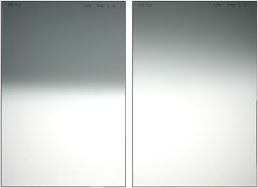
A neutral-density filter is one that reduces the intensity of the light reaching the film or sensor without changing the colour balance. Standard neutral-density filters are therefore used to increase exposure times and hence allow smaller apertures to be used. The resulting increase in depth of field can be very useful.
Graduated neutral-density (ND) filters are used principally by landscape photographers to control the contrast in an image. The sky in a typical image may be so much brighter than the foreground that the range of brightness exceeds the exposure latitude of even the best film or sensor. One way to handle such situations is to attach a graduated neutral-density filter to the lens. In the case of the rectangular types shown above, the filter can then be slid up and down over the lens in a slotted holder until the graduated transition between dense and transparent areas is in the ideal location - usually somewhere near the horizon.
ND grads are available with so-called hard and soft transitions, and also in one, two and three stop varieties usually known as 0.3, 0.6 and 0.9. In the illustration above, the left-hand filter is of the hard transition type, and the right-hand one has a soft transition. The latter type are somewhat easier to use because positioning is less critical, but give somewhat less dramatic results.
A range of coloured graduated filters is available for creative work.
Filter factors are generally 2 x to 8 x.






